
Where in early 2020 Instacart was the clear go-to for consumers looking to order from their preferred grocer online for curbside pickup or delivery, today the landscape has shifted.
Leading restaurant aggregators including DoorDash, Uber Eats and Grubhub are rapidly expanding their grocery offerings, and grocers have built out their in-house fulfillment capabilities. Now, Instacart is looking to offer more value from its network of pickers and drivers, diversifying beyond the grocery category.
In the past week, for instance, the company has partnered with home improvement retailer Lowe’s on same-day delivery and partnered with Delta Air Lines to offer SkyMiles as a reward for Instacart purchases.
Read more: Instacart, Lowe’s Offer Same-Day Delivery Service
Instacart Launches Miles Deal With Delta
At the start of this year, Instacart launched its Ready Meals Hub, allowing consumers to easily browse hot food options from grocers, providing a lower priced alternative to ordering cooked meals from restaurant aggregators.
See more: Instacart Aims to Price out DoorDash With Launch of Meal Delivery
Last year, the company launched on-demand delivery of arts and crafts supplies, discount goods and storage and organization items.
Read more: Michaels Teams With Instacart to Trial Same-Day Delivery
Five Below Expands Instacart Partnership for Same-Day Delivery
Instacart Teams With The Container Store for Same-Day Delivery
These efforts come as one-time restaurant aggregators grow aggressive in their grocery expansions. In the past couple of weeks alone, for instance, DoorDash launched 30-minute delivery in partnership with major grocery firm Albertsons Companies, and Grubhub announced a partnership with on-demand grocery delivery startup Buyk to offer 15-minute Buyk delivery through its marketplace.
See more: DoorDash, Albertsons Launch 30-Minute Grocery Delivery
Grubhub to Launch 15-Minute Grocery Delivery With Buyk
Instacart is also facing increased competition not only from other marketplace apps but also from the merchants on its own platform as they increasingly seek out other ways to offer delivery and pickup.
“If you were to ask the high-volume eCommerce retailers today in our franchise what they’re most worried about, the No. 1 thing they’re worried about in eCommerce … [is] the fact that they may be creating a business model for someone else on the backs of their own shoppers,” John Ross, president and CEO of the Independent Grocers Alliance (IGA), told PYMNTS in a PYMNTS TV interview in December. “Many of them accelerated in eCommerce the fastest and easiest way they could get there, but now, as they’re thinking about [creating] a more mature model for how they’re going to go forward, this issue is really, really, really important.”
Read more: Supermarkets Rethink Physical and Digital Aisles for Grocery’s Connected Future
Eighteen percent of consumers now purchase groceries digitally more frequently than they purchase them in stores, according to data from PYMNTS’ study “Decoding Customer Affinity: The Customer Loyalty to Merchants Survey 2022,” created in collaboration with Toshiba Global Commerce Solutions.
Get the report: The Customer Loyalty to Merchants Survey 2022
The report, which featured the results of a survey of a census-balanced panel of more than 2,000 U.S. consumers, also found that 23% of shoppers said that online purchasing capability would improve their loyalty to their grocery merchants, and 20% said the same of product delivery.